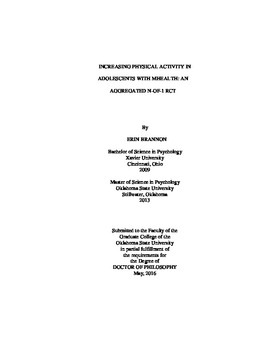| dc.contributor.advisor | Cushing, Christopher C. | |
| dc.contributor.author | Brannon, Erin | |
| dc.date.accessioned | 2018-06-25T13:38:35Z | |
| dc.date.available | 2018-06-25T13:38:35Z | |
| dc.date.issued | 2016-05 | |
| dc.identifier.uri | https://hdl.handle.net/11244/300276 | |
| dc.description.abstract | Social support and self-regulatory skills are two factors known to impact physical activity and sedentary behavior in adolescents. Given that adolescents are not meeting the recommended guidelines for physical activity (60 minutes daily or 9,000-14,000 steps) it is important to consider how these two factors can be incorporated in intervention programs. Current interventions development targeting social support and self-regulation are only just now beginning to capitalize on advancements in digital technology and most methods of intervention development are time-consuming and cost-inefficient. The aggregated N-of-1 RCT allows for an iterative process of intervention development that capitalizes on the use of technological interventions, and variability within participants to answer the question for whom did the intervention work, which is valuable in establishing the efficacy of behavioral intervention strategies prior to the inclusion in full-featured treatment packages. Ten adolescents (ages 13-18) participated in an N-of-1 RCT. Consistent with cybernetic control theory; adolescents set a daily physical activity goal. A Bioharness heart rate monitor assessed heart rate as proxy for goal attainment. Adolescents also self-monitored their physical activity in the Calorie Counter & Diet Tracker by MyFitnessPal app (commercially-available). Each night adolescents received a standardized text message providing feedback on goal attainment from a parent, nominated peer, or a behavioral health specialist (study staff); or no text message on control days. An Actigraph accelerometer recorded physical activity. The intervention demonstrated a significant effect for 30% of the sample. One adolescent (10%) increased their physical activity (step counts), while another two adolescents (20%) decreased time spent in sedentary activity. Feedback from all three providers demonstrated an increase over control in one of the two health behaviors. The effect of the intervention is consistent with other e-health and mobile health interventions targeting physical activity and sedentary behavior. The results suggest that some form of intervention can produce changes in these important behaviors by sending a text message from an influential person in an adolescent's life. This type of intervention module shows potential as it is easily administered and time-effective. The results have both research and clinical implications for intervention development. | |
| dc.format | application/pdf | |
| dc.language | en_US | |
| dc.rights | Copyright is held by the author who has granted the Oklahoma State University Library the non-exclusive right to share this material in its institutional repository. Contact Digital Library Services at lib-dls@okstate.edu or 405-744-9161 for the permission policy on the use, reproduction or distribution of this material. | |
| dc.title | Increasing physical activity in adolescents with mHealth: An aggregated N-of-1 RCT | |
| dc.contributor.committeeMember | Mullins, Larry L. | |
| dc.contributor.committeeMember | Leffingwell, Thad R. | |
| dc.contributor.committeeMember | Crick, Christopher | |
| osu.filename | Brannon_okstate_0664D_14105.pdf | |
| osu.accesstype | Open Access | |
| dc.type.genre | Dissertation | |
| dc.type.material | Text | |
| thesis.degree.discipline | Psychology | |
| thesis.degree.grantor | Oklahoma State University | |
